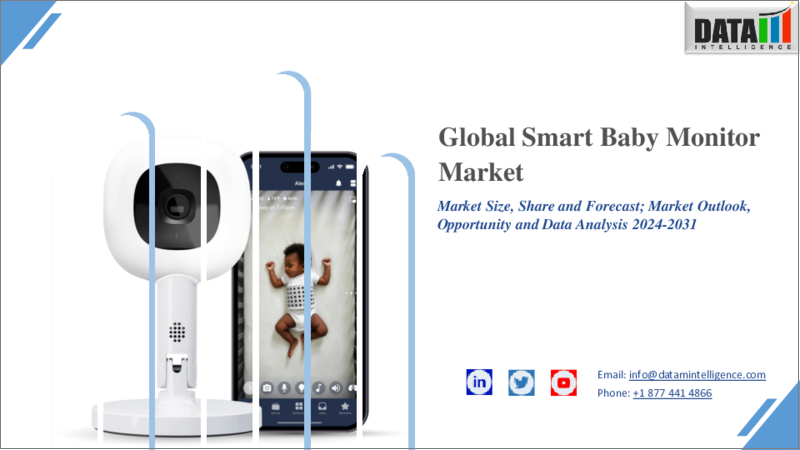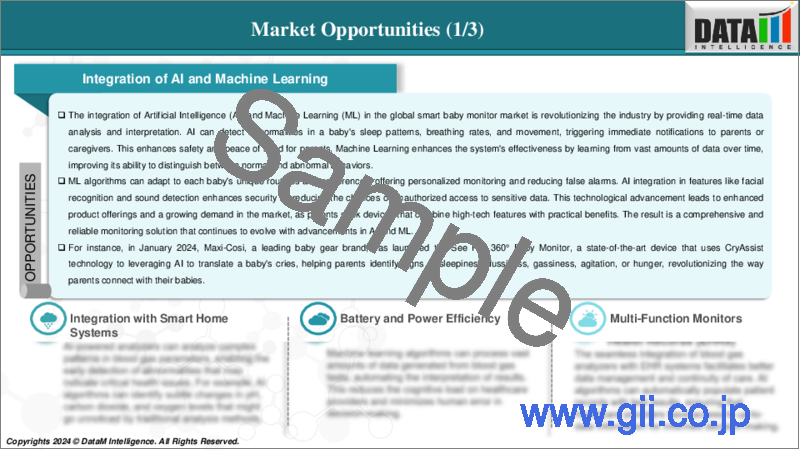|
|
市場調査レポート
商品コード
1606521
スマートベビーモニターの世界市場-2024~2031年Global Smart Baby Monitor Market - 2024-2031 |
||||||
カスタマイズ可能
適宜更新あり
|
|||||||
| スマートベビーモニターの世界市場-2024~2031年 |
|
出版日: 2024年12月04日
発行: DataM Intelligence
ページ情報: 英文 176 Pages
納期: 即日から翌営業日
|
- 全表示
- 概要
- 目次
概要
スマートベビーモニターの世界市場は2023年に17億米ドルに達し、2031年には26億米ドルに達すると予測され、予測期間2024年~2031年のCAGRは5.8%で成長する見込みです。
スマートベビーモニターは、子供の安全と親の利便性を確保するためのハイテク機器です。スマートベビーモニターは、従来のベビーモニターに最新技術を付加したものです。動体検知アラーム、心拍数・酸素濃度検知、温度センサー、双方向通信などのイントロダクションより、単なる音声・映像記録にとどまらないです。スマートベビーモニターはWi-FiやBluetoothと連動し、親はモバイルアプリケーションや画面を使って、どこからでも赤ちゃんの様子を観察できます。睡眠中の赤ちゃんの安全を守るものから、発達の動向や変化を追跡するものまで、その種類は多岐にわたる。
市場力学:
促進要因と抑制要因
技術進歩の台頭
技術の進歩は、世界のスマートベビーモニター市場の成長を促進する最も重要な要因の一つです。これは、親が子供を監視しケアする方法における革命です。AIベースの分析、IoT統合、高度なセンサーなどの新技術により、現在のベビーモニターは単純なオーディオビジュアル機器から、心拍数、酸素レベル、睡眠パターン、その他のバイタルサインを測定できる洗練されたツールへと変貌を遂げています。Wi-Fiとクラウド機能によってリアルタイムモニタリングが可能になったことで、親は離れていても連絡を取ることができるようになった。機械学習と音声認識の強化された発展により、モニターのためのパーソナライズされた洞察とアラートがその機能を豊かにしています。
例えば、2024年10月、ロイヤルフィリップスはフィリップス・アベント・プレミアム・コネクテッド・ベビーモニターを発売しました。この装置には、ベビーユニットカメラ、ペアレントユニット、親が赤ちゃんをモニターするためのモバイルアプリが含まれています。SenseIQトラッキング技術は、数十億のピクセルを評価し、胸の動きを睡眠状態と呼吸数のアップデートに変換します。
データのプライバシーとセキュリティ
世界のスマートベビーモニター市場は、データプライバシーとセキュリティの懸念による課題に直面しています。Wi-Fi、Bluetooth、クラウドベースの技術に依存するこれらのデバイスは、ハッキングや不正アクセスに対して脆弱であり、ビデオフィードや個人データなどの機密情報が流出する可能性があります。強固な暗号化規格がなく、ブランド間でセキュリティ対策に一貫性がないことが、この問題をさらに悪化させています。メーカーは高度なセキュリティ・プロトコルに投資し、消費者に安全な使用方法を教育する必要があるが、これは製品の複雑さと開発コストを増大させ、市場の成長を鈍化させる可能性があります。
目次
第1章 調査手法と調査範囲
第2章 定義と概要
第3章 エグゼクティブサマリー
第4章 市場力学
- 影響要因
- 促進要因
- 技術進歩の高まり
- 促進要因
- 抑制要因
- データのプライバシーとセキュリティに関する懸念
- 機会
- 影響分析
第5章 産業分析
- ポーターのファイブフォース分析
- サプライチェーン分析
- 価格分析
- 規制分析
第6章 製品タイプ別
- ビデオモニター
- オーディオモニター
- 動きモニター
- その他
第7章 コミュニケーションのモード別
- 有線
- 無線
第8章 流通チャネル別
- オンライン
- ハイパーマーケット/スーパーマーケット
- 専門店
- その他
第9章 地域別
- 北米
- 米国
- カナダ
- メキシコ
- 欧州
- ドイツ
- 英国
- フランス
- スペイン
- イタリア
- その他欧州地域
- 南米
- ブラジル
- アルゼンチン
- その他南米
- アジア太平洋地域
- 中国
- インド
- 日本
- 韓国
- その他アジア太平洋地域
- 中東・アフリカ
第10章 競合情勢
- 競合シナリオ
- 市況・シェア分析
- M&A分析
第11章 企業プロファイル
- VTech Communications, Inc
- 会社概要
- 製品ポートフォリオと概要
- 財務概要
- 主な発展
- Motorola, Inc
- Dorel Industries Inc.
- Panasonic Corporation
- Samsung Electronics Co. Ltd.
- Netgear Inc.
- Lorex Technology Inc.
- Summer Infant, Inc.
- Arlo Technologies, Inc.
- iBaby Labs, Inc.
第12章 付録
Overview
The global smart baby monitor market reached US$ 1.7 billion in 2023 and is expected to reach US$ 2.6 billion by 2031, growing at a CAGR of 5.8% during the forecast period 2024-2031.
Smart baby monitors are high-tech gadgets for ensuring a child's safety and great convenience for parents. They have an added-on feature of modern technology into conventional baby monitors. They go beyond just audio and visual recording by the introduction of features, such as an alarm for motion detection, heart rate and oxygen level detection, temperature sensors, and even two-way communication. Smart baby monitors work with Wi-Fi and Bluetooth, allowing the parents to observe their infants from anywhere using their mobile applications or screens. They vary widely from keeping a baby safe while sleeping to tracking developmental trends and changes.
Market Dynamics: Drivers & Restraints
Rise in Technological Advancements
Technological advancement is one of the most important factors fuelling the growth of the global smart baby monitor market. This is the revolution in the way parents can monitor and care for their children. With new technologies like AI-based analytics, IoT integration, and advanced sensors, current baby monitors have transformed from simple audio-visual devices into a sophisticated tool that can measure heart rate, oxygen levels, sleep patterns, and other vital signs. The simple fact that real-time monitoring can be facilitated through a Wi-Fi and cloud facility enables parents to be in touch even while away. Enhanced developments of machine learning and voice recognition have personalized insights and alerts for the monitors to enrich its functionality.
For instance, in October 2024, Royal Philips has launched the Philips Avent Premium Connected Baby Monitor, featuring SenseIQ sleep, breathing-tracking, and cry-detection technologies. The device includes a baby unit camera, parent unit, and a mobile app for parents to monitor their baby. The SenseIQ tracking technology evaluates Billions of pixels and converts chest motions into sleep status and breathing rate updates.
Data Privacy and Security Concerns
The global smart baby monitor market faces challenges due to data privacy and security concerns. These devices, relying on Wi-Fi, Bluetooth, and cloud-based technology, are vulnerable to hacking and unauthorized access, exposing sensitive information like video feeds and personal data. The lack of robust encryption standards and inconsistent security measures across brands further exacerbate the issue. Manufacturers must invest in advanced security protocols and educate consumers on safe usage practices, but this could increase product complexity and development costs, potentially slowing market growth.
Segment Analysis
The global smart baby monitor market is segmented based on product type, mode of communication, distribution channel and region.
Product type:
Video monitors segment is expected to dominate the smart baby monitor market share
The video monitors segment holds a major portion of the smart baby monitor market share and is expected to continue to hold a significant portion of the smart baby monitor market share during the forecast period.
Video baby monitors are a significant part of the smart baby monitor market due to their comprehensive monitoring capabilities, which allow parents to remotely monitor their children's activities. These devices offer audio and visual insights, enhancing parents' peace of mind. Additionally, many video monitors come with advanced features like night vision, temperature monitoring, motion detection, and alerts for unusual activity, making them increasingly important for parents ensuring their child's well-being.
For instance, in August 2024, Jartoo, a leading baby care technology company, has introduced a revolutionary baby monitor with an exclusive cry sensor and 2K video quality, providing parents with enhanced safety, convenience, and peace of mind.
Distribution channel:
Online segment is the fastest-growing segment in smart baby monitor market share
The online segment is the fastest-growing segment in the smart baby monitor market share and is expected to hold the market share over the forecast period.
The global smart baby monitor market is significantly influenced by the online segment, which serves as a distribution channel for both established brands and emerging players. E-commerce platforms like Amazon and Walmart offer consumers a convenient way to compare features, prices, and reviews of smart baby monitors. This has expanded the market's reach, allowing brands to cater to a global audience without the need for extensive physical retail infrastructure. The integration of user-generated content builds consumer trust and drives purchasing decisions. As digital penetration and smartphone usage increase, the online segment is expected to remain dominant.
In August 2023, Masimo, a renowned global leader in noninvasive monitoring technologies, officially launched its innovative Stork smart home baby monitoring system in the U.S. The Stork system is designed to provide parents with an advanced, reliable way to monitor the health and well-being of their babies from the comfort of their home.
Geographical Analysis
North America is expected to hold a significant position in the smart baby monitor market share
North America holds a substantial position in the smart baby monitor market and is expected to hold most of the market share.
North America is a key player in the global smart baby monitor market due to high consumer awareness, adoption of advanced technologies, and emphasis on child safety. The region's robust internet infrastructure and high smartphone penetration enable seamless connectivity and remote monitoring capabilities. Rising disposable incomes and a preference for premium products contribute to market growth. Major players and continuous technological innovation in the US and Canada enhance product availability and diversity. Government regulations and standards for baby safety further encourage the adoption of these devices, positioning North America as a key driver in the global smart baby monitor market.
For instance, in February 2024, US infant-care start-up Harbor has raised $3.7m in a seed round to launch a smart baby monitor that streams with or without internet access. The idea was conceived after co-founder and CEO Kevin Lavelle, chairman of Mizzen+Main, experienced a camera losing connection to his phone's app, proving that app-based systems cannot be trusted as true baby monitors.
Asia-Pacific is growing at the fastest pace in the smart baby monitor market
Asia-Pacific holds the fastest pace in the smart baby monitor market and is expected to hold most of the market share.
The Asia-Pacific region is driving growth in the global smart baby monitor market due to urbanization, rising disposable incomes, and child safety awareness. The middle-class population in the region is demanding advanced baby care products, including smart monitors. Countries like China, Japan, South Korea, and India are adopting IoT and smart home technologies, creating a favourable environment for market expansion. The growing number of working parents in the region emphasizes the need for reliable, real-time monitoring solutions. E-commerce growth and affordable smart baby monitors from local and international players further enhance market accessibility.
For instance, in February 2023, Bonoch, a smart childcare brand, has introduced a long-range baby monitor that offers comprehensive coverage throughout the household without requiring a Wi-Fi connection, providing a worry-free experience for parents of young children.
Moreover, in May 2024, Xiaomi has launched its "Baby Care Edition" smart camera in China, offering a comprehensive monitoring solution with intelligent features, focusing on parental peace of mind and privacy.
Competitive Landscape
The major global players in the smart baby monitor market include VTech Communications, Inc, Motorola, Inc, Dorel Industries Inc, Panasonic Corporation, Samsung Electronics Co. Ltd, Netgear Inc, Lorex Technology Inc, Summer Infant, Inc., Arlo, Technologies, Inc, iBaby Labs, Inc among others.
Emerging Players
The emerging players in the smart baby monitor market include Nanit, Owlet, Inc, Hubble Connected Angelcare Monitors Inc and among others.
Key Developments
- In October 2024, Tiny Traveler, a baby monitoring company, has partnered with Kneron, a leader in edge AI technology, to release a series of smart baby cameras equipped with Kneron's advanced AI chips. This collaboration aims to support infant safety and development, transforming how parents can remotely monitor and engage with their children, thereby enhancing their child-rearing experience.
- In September 2023, VTech, a pioneer in parenting technology, has introduced its latest product, the V-Care VC2105 Smart Nursery Baby Monitor, which uses local AI for real-time alerts and baby sleep analytics, making it the best monitor on the market.
Why Purchase the Report?
- Pipeline & Innovations: Reviews ongoing clinical trials, product pipelines, and forecasts upcoming advancements in medical devices and pharmaceuticals.
- Product Performance & Market Positioning: Analyzes product performance, market positioning, and growth potential to optimize strategies.
- Real-World Evidence: Integrates patient feedback and data into product development for improved outcomes.
- Physician Preferences & Health System Impact: Examines healthcare provider behaviors and the impact of health system mergers on adoption strategies.
- Market Updates & Industry Changes: Covers recent regulatory changes, new policies, and emerging technologies.
- Competitive Strategies: Analyzes competitor strategies, market share, and emerging players.
- Pricing & Market Access: Reviews pricing models, reimbursement trends, and market access strategies.
- Market Entry & Expansion: Identifies optimal strategies for entering new markets and partnerships.
- Regional Growth & Investment: Highlights high-growth regions and investment opportunities.
- Supply Chain Optimization: Assesses supply chain risks and distribution strategies for efficient product delivery.
- Sustainability & Regulatory Impact: Focuses on eco-friendly practices and evolving regulations in healthcare.
- Post-market Surveillance: Uses post-market data to enhance product safety and access.
- Pharmacoeconomics & Value-Based Pricing: Analyzes the shift to value-based pricing and data-driven decision-making in R&D.
The global smart baby monitor market report delivers a detailed analysis with 60+ key tables, more than 50 visually impactful figures, and 176 pages of expert insights, providing a complete view of the market landscape.
Target Audience 2023
- Manufacturers: Pharmaceutical, Medical Device, Biotech Companies, Contract Manufacturers, Distributors, Hospitals.
- Regulatory & Policy: Compliance Officers, Government, Health Economists, Market Access Specialists.
- Technology & Innovation: AI/Robotics Providers, R&D Professionals, Clinical Trial Managers, Pharmacovigilance Experts.
- Investors: Healthcare Investors, Venture Fund Investors, Pharma Marketing & Sales.
- Consulting & Advisory: Healthcare Consultants, Industry Associations, Analysts.
- Supply Chain: Distribution and Supply Chain Managers.
- Consumers & Advocacy: Patients, Advocacy Groups, Insurance Companies.
- Academic & Research: Academic Institutions.
Table of Contents
1. Methodology and Scope
- 1.1. Research Methodology
- 1.2. Research Objective and Scope of the Report
2. Definition and Overview
3. Executive Summary
- 3.1. Snippet by Product Type
- 3.2. Snippet by Mode of Communication
- 3.3. Snippet by Distribution channel
- 3.4. Snippet by Region
4. Dynamics
- 4.1. Impacting Factors
- 4.1.1. Drivers
- 4.1.1.1. Rise in Technological Advancements
- 4.1.1. Drivers
- 4.2. Restraints
- 4.2.1. Data Privacy and Security Concerns
- 4.3. Opportunity
- 4.3.1. Impact Analysis
5. Industry Analysis
- 5.1. Porter's Five Force Analysis
- 5.2. Supply Chain Analysis
- 5.3. Pricing Analysis
- 5.4. Regulatory Analysis
6. By Product type
- 6.1. Introduction
- 6.1.1. Market Size Analysis and Y-o-Y Growth Analysis (%), By Product type
- 6.1.2. Market Attractiveness Index, By Product type
- 6.2. Video Monitors*
- 6.2.1. Introduction
- 6.2.2. Market Size Analysis and Y-o-Y Growth Analysis (%)
- 6.3. Audio Monitors
- 6.4. Movement Monitors
- 6.5. Others
7. By Mode of communication
- 7.1. Introduction
- 7.1.1. Market Size Analysis and Y-o-Y Growth Analysis (%), By Mode of communication
- 7.1.2. Market Attractiveness Index, By Mode of communication
- 7.2. Wired*
- 7.2.1. Introduction
- 7.2.2. Market Size Analysis and Y-o-Y Growth Analysis (%)
- 7.3. Wireless
8. By Distribution channel
- 8.1. Introduction
- 8.1.1. Market Size Analysis and Y-o-Y Growth Analysis (%), By Distribution channel
- 8.1.2. Market Attractiveness Index, By Distribution channel
- 8.2. Online*
- 8.2.1. Introduction
- 8.2.2. Market Size Analysis and Y-o-Y Growth Analysis (%)
- 8.3. Hypermarket/Supermarket
- 8.4. Specialty Stores
- 8.5. Others
9. By Region
- 9.1. Introduction
- 9.1.1. Market Size Analysis and Y-o-Y Growth Analysis (%), By Region
- 9.1.2. Market Attractiveness Index, By Region
- 9.2. North America
- 9.2.1. Introduction
- 9.2.2. Key Region-Specific Dynamics
- 9.2.3. Market Size Analysis and Y-o-Y Growth Analysis (%), By Product Type
- 9.2.4. Market Size Analysis and Y-o-Y Growth Analysis (%), By Mode of Communication
- 9.2.5. Market Size Analysis and Y-o-Y Growth Analysis (%), By Distribution channel
- 9.2.6. Market Size Analysis and Y-o-Y Growth Analysis (%), By Country
- 9.2.6.1. U.S.
- 9.2.6.2. Canada
- 9.2.6.3. Mexico
- 9.3. Europe
- 9.3.1. Introduction
- 9.3.2. Key Region-Specific Dynamics
- 9.3.3. Market Size Analysis and Y-o-Y Growth Analysis (%), By Product Type
- 9.3.4. Market Size Analysis and Y-o-Y Growth Analysis (%), By Mode of Communication
- 9.3.5. Market Size Analysis and Y-o-Y Growth Analysis (%), By Distribution channel
- 9.3.6. Market Size Analysis and Y-o-Y Growth Analysis (%), By Country
- 9.3.6.1. Germany
- 9.3.6.2. U.K.
- 9.3.6.3. France
- 9.3.6.4. Spain
- 9.3.6.5. Italy
- 9.3.6.6. Rest of Europe
- 9.4. South America
- 9.4.1. Introduction
- 9.4.2. Key Region-Specific Dynamics
- 9.4.3. Market Size Analysis and Y-o-Y Growth Analysis (%), By Product Type
- 9.4.4. Market Size Analysis and Y-o-Y Growth Analysis (%), By Mode of Communication
- 9.4.5. Market Size Analysis and Y-o-Y Growth Analysis (%), By Distribution channel
- 9.4.6. Market Size Analysis and Y-o-Y Growth Analysis (%), By Country
- 9.4.6.1. Brazil
- 9.4.6.2. Argentina
- 9.4.6.3. Rest of South America
- 9.5. Asia-Pacific
- 9.5.1. Introduction
- 9.5.2. Key Region-Specific Dynamics
- 9.5.3. Market Size Analysis and Y-o-Y Growth Analysis (%), By Product Type
- 9.5.4. Market Size Analysis and Y-o-Y Growth Analysis (%), By Mode of Communication
- 9.5.5. Market Size Analysis and Y-o-Y Growth Analysis (%), By Distribution channel
- 9.5.6. Market Size Analysis and Y-o-Y Growth Analysis (%), By Country
- 9.5.6.1. China
- 9.5.6.2. India
- 9.5.6.3. Japan
- 9.5.6.4. South Korea
- 9.5.6.5. Rest of Asia-Pacific
- 9.6. Middle East and Africa
- 9.6.1. Introduction
- 9.6.2. Key Region-Specific Dynamics
- 9.6.3. Market Size Analysis and Y-o-Y Growth Analysis (%), By Product Type
- 9.6.4. Market Size Analysis and Y-o-Y Growth Analysis (%), By Mode of Communication
- 9.6.5. Market Size Analysis and Y-o-Y Growth Analysis (%), By Distribution channel
10. Competitive Landscape
- 10.1. Competitive Scenario
- 10.2. Market Positioning/Share Analysis
- 10.3. Mergers and Acquisitions Analysis
11. Company Profiles
- 11.1. VTech Communications, Inc*
- 11.1.1. Company Overview
- 11.1.2. Product Portfolio and Description
- 11.1.3. Financial Overview
- 11.1.4. Key Developments
- 11.2. Motorola, Inc
- 11.3. Dorel Industries Inc.
- 11.4. Panasonic Corporation
- 11.5. Samsung Electronics Co. Ltd.
- 11.6. Netgear Inc.
- 11.7. Lorex Technology Inc.
- 11.8. Summer Infant, Inc.
- 11.9. Arlo Technologies, Inc.
- 11.10. iBaby Labs, Inc.
LIST NOT EXHAUSTIVE
12. Appendix
- 12.1 About Us and Services
- 12.2 Contact Us






